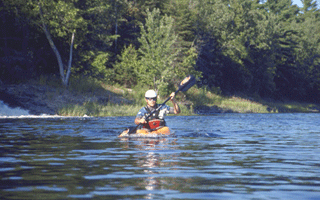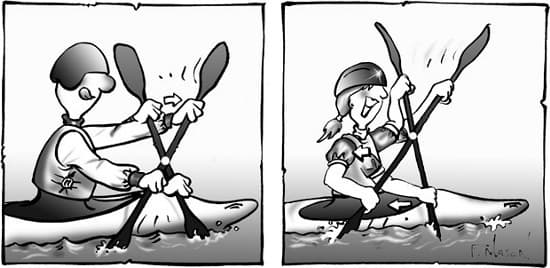The Forward Stroke - Whitewater
Whitewater kayaks are designed to turn efficiently, so mastering a stroke that is supposed to make them go straight isn't going to be easy. When you're learning, you'll probably find that paddling in a straight line is next to impossible. If you're having trouble doing so, then you'll probably be happy to hear that you're not the only one. In fact, no one can paddle a whitewater kayak in a straight line and everyone has difficulty just getting from A to B in the beginning. Even the best whitewater paddlers are turning back and forth slightly with each stroke. What happens is that as you get better, you start anticipating any corrections rather than reacting to the actions of your kayak. Having said this, we're going to be looking at what could be considered the ideal forward stroke. The reality is that each of your forward strokes will need to be modified slightly to accommodate any correction that is needed.
When looking at the ideal forward stroke for sea kayaking, one commonly looks at the relationship of the body and paddle with the water. With whitewater kayaking, we have to look at things slightly differently because of the relationship between your boat and the water. With that said, we're going to quickly look at three different aspects of the forward stroke. We'll look at what the paddle is doing, what the body is doing, and finally, what the boat is doing.
Starting with the paddle, the forward stroke starts at the toes and ends at the hip. To get the most forward pull out of each stroke, your paddle should be as vertical as possible and your blade should pull directly alongside your boat. If you're getting lots of splash at the beginning of your stroke, then you know your paddle isn't planted deeply enough in the water. Also, one of the most common errors is pulling the forward stroke past the hip. If your stroke passes your hip, your paddle will actually start pulling up against the water, and it will begin turning your boat. Of course this can be useful for making small corrections, but if they're not needed, then get your blade out of the water before it passes your hip and plant your next stroke at your toes.
Next, let's look at how the body works with the paddle. We'll start by looking at the top hand. The top hand should stay at around eye level throughout the stroke. Try to avoid punching forward too aggressively with this hand as you perform the stroke. The isolated effect of punching forward is to cause your lower blade to pull up against the water at the end of each stroke, which just creates more drag on your kayak. Think more about driving your upper shoulder forward and keeping that elbow down. This encourages torso rotation, which puts the power of your whole upper body behind your stroke. If you're effectively using torso rotation, your body should be wound up from the hips for each stroke you take. Once your body is wound up, don't hesitate before planting your stroke.
Your body is like an elastic band. If it's wound up, it will naturally want to unwind, and so the longer you take to get your next blade in the water, the more potential power (from the torso rotation) you will lose. This is where the third Golden Rule comes into play (see Golden Rules article). By keeping an active paddle in the water you'll maximize on the power that comes from your torso rotation. As for your actual body position, a moderately aggressive body position is ideal. This means sitting upright with a slight lean forward. This forward position helps keep your stern edges from inadvertently catching when you're in current.


With the smaller whitewater kayaks and with playboats you'll also need to worry about having your bow dive underwater. This will definitely be new territory for avid sea kayakers. To avoid this, you'll sometimes have no choice but to lean back for a moment. For instance, you may need to lean back when crossing eddy lines, or when paddling against the current as you do when ferrying. It's important to understand that there's no problem with leaning back, as long as you return to your neutral or moderately aggressive position as soon as it is possible.
Finally, your boat's activity is an important factor in the effectiveness of your forward stroke. Ideally, your kayak would stay perfectly level as you paddle. Although this may be feasible when paddling on flatwater, this is an unrealistic expectation when there are waves or currents to contend with, particularly in smaller playboats. You can make small modifications as you paddle to keep your bow from diving underwater. By tilting your boat a little and very briefly into each stroke, this will slice your stern slightly under water and keep your bow on top of the water.
This forward paddling technique will come in really handy when ferrying, or when paddling through wave trains. Don't forget that since your forward strokes are most effective with a level boat and digging your stern in too much can make you unstable, you want to minimize the amount of tilt you use.
Although you might have figured that the forward stroke would be the easiest stroke to master, there are a remarkable number of things that you need to think about. In fact, entire books have been written just on the forward stroke! Try focusing on each component individually and don't get frustrated when your boat doesn't respond the way you want it to. Remember that whitewater kayaks were not designed to go straight.


1) Punching forward with the top hand doesn't provide your strokes with as much power, as the pivot point on your paddle is closer to your bottom hand.
2) Driving your shoulder forward with each stroke encourages torso rotation and gives each stroke more power as the pivot point will be closer to your top hand.
Related Articles
Even though they are flipping over, missing their gates and failing their maneuvers, they still look…
In this video, we're going to look at five kayaking tips that will help make you a better paddler, or…
Most paddlers will develop a forward stroke that is powerful enough to get them where they need to go,…
Eddy turns are the foundation for paddling in current, enabling you to enter and exit river and tidal…


